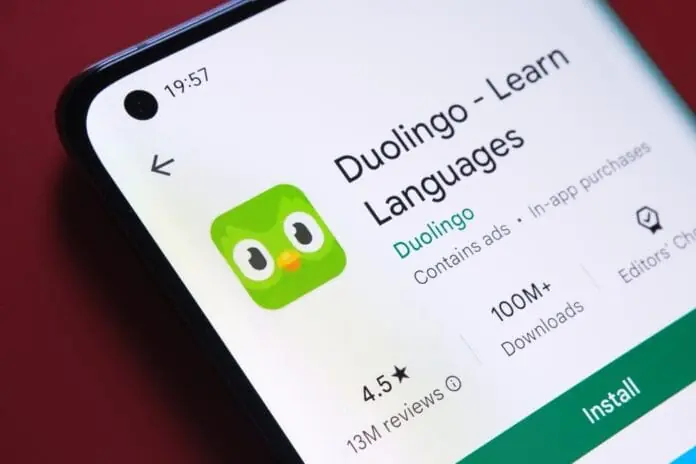Duolingo doesn’t feel like school. No thick textbooks, no long grammar explanations. Just quick lessons, colorful animations, and a little sound effect when you get something right. It’s simple, but that’s exactly why it works.
It’s not just an app—it’s a game. Earn points, keep your streak, climb the leaderboard. The longer you play, the harder it is to stop. Not because you have to, but because you want to.
Seems effortless, but it’s all by design. People love small wins, and Duolingo figured out how to make language learning addictive. It’s not about memorizing rules—it’s about showing up, every single day.
So how did they pull it off? Let’s break it down.
The Rise of Duolingo
It didn’t start as a billion-dollar company. Duolingo began as an experiment. Back in 2011, Luis von Ahn—yes, the guy behind CAPTCHA—had a simple idea: What if learning a language was free? Not just free, but fun.
At the time, language courses were expensive. Apps like Rosetta Stone charged hundreds of dollars. Schools weren’t an option for everyone. Von Ahn wanted to flip that model upside down. Instead of making users pay, Duolingo would be completely free—and instead of dry, textbook-style lessons, it would feel like a game.
Sounds good in theory, but getting people to actually stick with it? That was the real challenge. Most people give up on language learning within a few weeks. Duolingo had to figure out how to keep them coming back.
So they made it easy. No overwhelming grammar charts. No long explanations. Just bite-sized lessons, instant feedback, and tiny dopamine hits every time you got something right. Before users even realized it, they were hooked.
It didn’t take long for the app to blow up. By 2013, Duolingo had millions of users. By 2020, it was the most downloaded education app in the world. Not bad for a free app with a cartoon owl as its mascot.
But success wasn’t just about being free—it was about making language learning feel effortless. And that’s where gamification came in.
Understanding Gamification in Duolingo
Most people want to learn a language. Few actually stick with it. Not because they don’t care, but because it’s hard. Motivation fades. Textbooks get boring. Progress feels slow.
Duolingo’s answer? Make learning feel like a game. Not in a gimmicky way, but in a way that keeps people coming back—day after day, lesson after lesson.
Gamification isn’t just about adding points and badges. It’s about psychology. People love challenges, rewards, and a sense of progress. Duolingo taps into that.
- Streaks: Miss a day? You lose your streak. Keep going, and you feel like you’re building something.
- XP & Levels: Earn points, unlock new ranks—it’s satisfying to see progress.
- Leaderboards: A little competition keeps things interesting. Nobody wants to drop from the top.
- Lives & Hearts: Make too many mistakes? You run out of chances. Now there’s a reason to focus.
It’s not about forcing users to learn. It’s about making them want to. When lessons feel like a challenge instead of a chore, people show up. And when they show up, they improve.
Duolingo isn’t alone in this approach. Fitness apps have been using gamification to keep people engaged for years. The same psychological triggers that make Duolingo addictive also make fitness apps like Strava and Fitbit so effective. We covered this trend in detail in our article: Gamification of Fitness: How Apps Are Making Exercise Addictive
That’s the magic of gamification. Duolingo didn’t just build a language app. It built a habit.
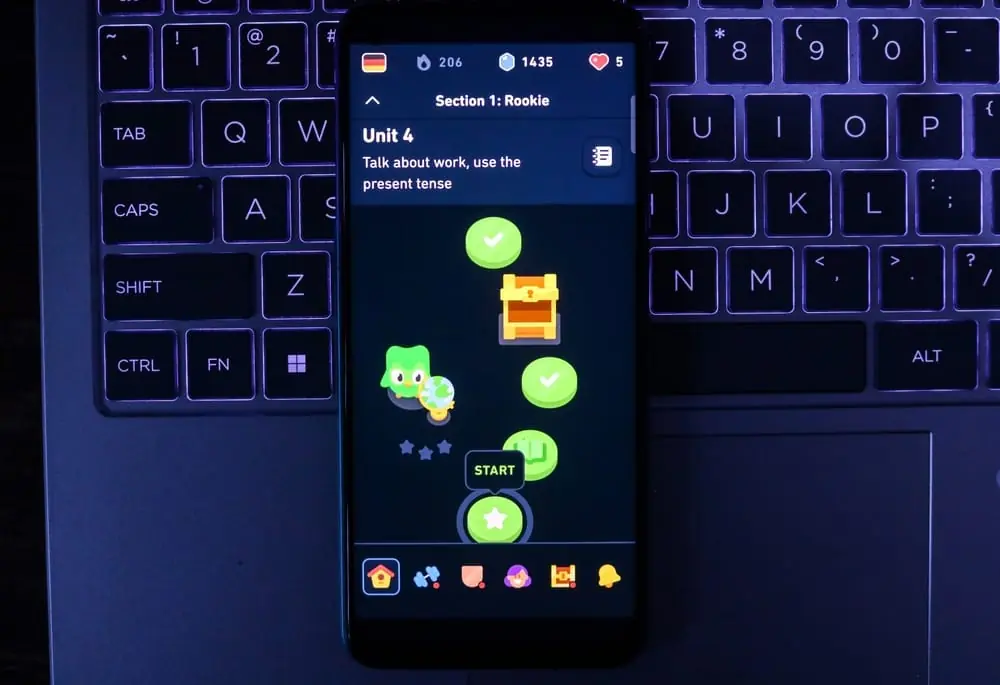
Key Gamification Features in Duolingo
Duolingo doesn’t just use gamification—it masters it. Every part of the app is designed to keep users engaged, whether they realize it or not. It’s not about tricking people into learning; it’s about making learning feel rewarding.
Here’s how they do it:
Streaks: The Power of Not Breaking the Chain
Nothing feels worse than losing a streak. One missed day, and it’s gone. It’s a simple psychological trick, but it works. People will go out of their way to do a lesson just to keep their streak alive. Some even buy “Streak Freezes” to make sure they don’t lose it.
XP & Levels: Turning Learning into a Progress Bar
Every lesson earns XP (experience points). More XP means higher levels. Why does this work? Because progress feels good. It’s the same reason video games are addictive—there’s always a next step, always something new to unlock.
Leaderboards: A Little Friendly Competition
Nobody likes finishing last. Duolingo’s leaderboards tap into our competitive side. Users are grouped into leagues, where they can move up by earning more XP. It’s not just about learning—it’s about winning. And winning feels good.
Hearts & Mistakes: A Built-In Challenge
Make too many mistakes, and you’re out of hearts. That means you can’t keep going until you either wait for hearts to refill or practice old lessons. This adds stakes to each lesson—users focus more because they don’t want to lose their chance to progress.
Gems & In-App Rewards: A Virtual Economy
Duolingo has its own currency. Earn gems, spend gems. Want to unlock a fun bonus lesson? Buy it with gems. Want a new outfit for the owl? That’ll cost you too. It keeps people engaged by giving them something extra to work toward.
Challenges & Badges: Collecting Achievements
People love collecting things. Duolingo rewards users with badges for hitting milestones—completing lessons, maintaining streaks, or reaching XP goals. These little rewards make the journey feel more satisfying.
Why This Works
Gamification isn’t just about adding fun features. It’s about creating habits. By turning language learning into a daily challenge with clear rewards, Duolingo keeps users engaged longer than traditional methods ever could.
And that’s why it’s not just an app—it’s a daily ritual for millions.
How Gamification Boosts User Retention
Duolingo isn’t just about learning—it’s about coming back every single day. That’s the real secret. A good language app isn’t just one people download—it’s one they actually use.
Most people start learning a language full of motivation. Then life gets busy. They skip a day. Then another. Before they know it, they’ve quit. Duolingo’s gamification prevents that from happening.
Here’s how:
Habit Formation: Making Learning Automatic
The hardest part of learning isn’t the content—it’s showing up. Duolingo turns daily practice into a habit. The streak feature keeps users accountable, while notifications remind them just when they might forget. One lesson a day. That’s all it takes. And once the habit is in place, users are hooked.
Loss Aversion: The Fear of Losing Progress
Nobody wants to lose what they’ve built. A 50-day streak? That’s not something you throw away. This taps into loss aversion, a psychological principle that makes people more likely to keep something than risk losing it. It’s why people go out of their way to do one quick lesson at midnight—just to keep that streak alive.
Micro-Rewards: Small Wins, Big Impact
Every lesson earns XP. Every streak feels like progress. Even just getting a little “Great Job!” message can be enough motivation to continue. These small psychological rewards make learning feel good, which makes users come back for more.
Competition & Social Proof: Learning with Others
Leaderboards don’t just make things fun—they make them social. When users see their friends climbing ranks, they feel motivated to do the same. Even without friends, competing against strangers in leagues gives users a reason to log in every day.
Personalized Learning Paths: Keeping It Fresh
Repetition can be boring, but Duolingo balances it out by unlocking new skills, challenges, and achievements as users progress. There’s always something new to reach for. That keeps users engaged for the long run.
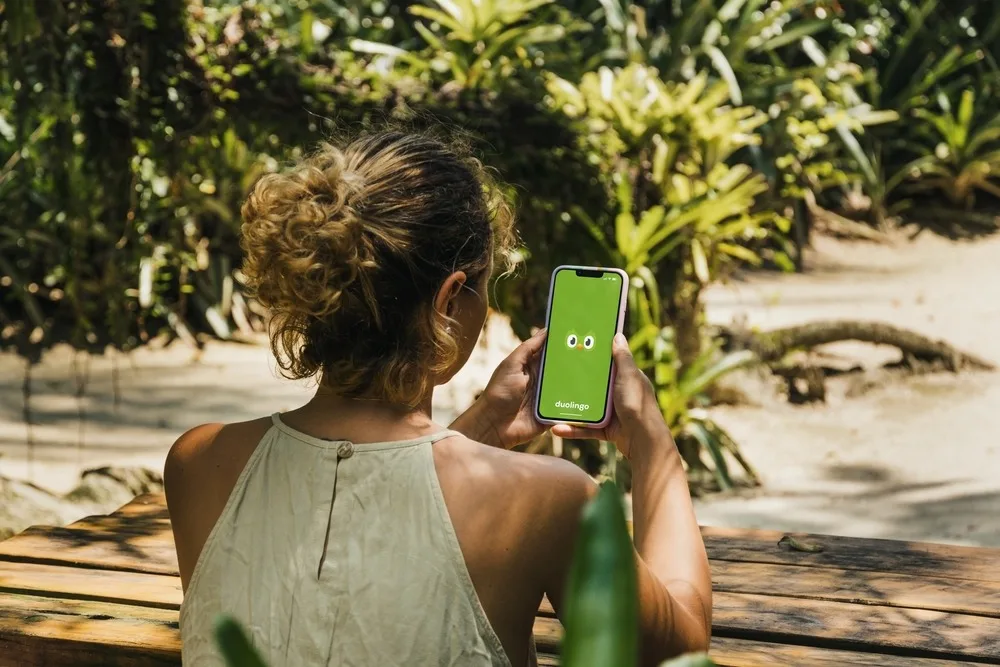
The Business Model Behind Duolingo’s Growth
Duolingo isn’t just a fun app—it’s a business. And a successful one. Millions of people use it for free, so how does it make money?
At first, Duolingo had no real business model. The goal was simple: make language learning free and accessible. Monetization came later, and when it did, it was built in a way that didn’t ruin the experience.
Here’s how Duolingo turned a free app into a profitable company.
1. The Freemium Model: Free for All, Paid for More
The core experience is free. Anyone can download Duolingo, complete lessons, and learn a language without ever paying a cent. That’s intentional—it keeps the user base massive.
But for those who want more, there’s Duolingo Super (formerly Duolingo Plus). It removes ads, lets users make unlimited mistakes (no hearts needed), and offers extra features like Personalized Practice and Mastery Quizzes. Not essential, but tempting enough that millions of users subscribe.
2. Ads: Making Free Still Profitable
If you don’t pay, you’ll see ads. At the end of every lesson, before unlocking new skills—Duolingo monetizes free users through advertising. With millions of active learners, even a few ads per session generate serious revenue.
3. In-App Purchases: Selling Virtual Goods
Duolingo has its own economy. Users earn “gems” for completing lessons, then spend them on streak freezes, bonus lessons, or fun cosmetic changes (like outfits for the owl).
It’s a small feature, but even microtransactions add up when millions of users participate.
4. Duolingo for Schools: Expanding into Education
It’s not just individuals using Duolingo. Teachers use it in classrooms. Schools integrate it into language programs. This educational expansion builds brand credibility and brings in institutional partnerships.
5. Duolingo English Test: A New Revenue Stream
In 2020, Duolingo launched an online English proficiency test—an alternative to TOEFL and IELTS. It’s cheaper, fully digital, and now accepted by thousands of universities worldwide. This move opened an entirely new revenue stream beyond just language learning.
The Secret to Duolingo’s Business Success
Most education apps struggle because people stop using them. Duolingo avoids this by making learning addictive. The more people come back, the more they watch ads, consider upgrades, or make small purchases.
It’s not just an app—it’s a self-sustaining business model built on engagement.
And that’s why Duolingo isn’t just popular—it’s profitable.
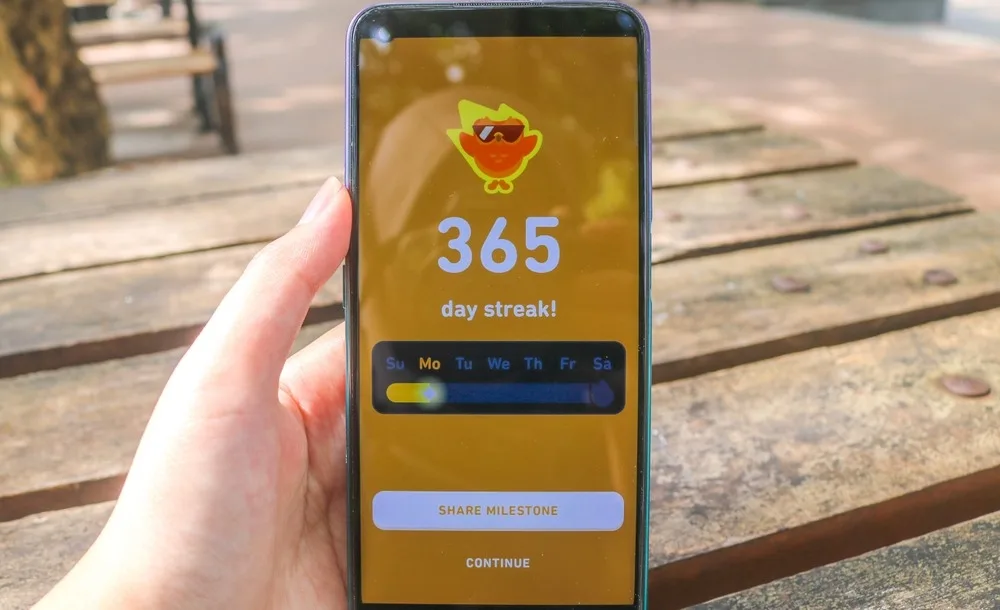
The Downsides of Duolingo’s Gamification
Duolingo keeps people learning, no doubt about that. But does it really teach a language? That’s where opinions start to split. Some love it. Others say it’s more of a game than a serious learning tool.
Here’s where things get tricky:
1. Winning vs. Learning
It feels good to rack up XP, move up the leaderboard, and keep that streak alive. But at what point does the game become the goal? Some users admit they log in just to maintain their streak, not necessarily to learn anything new.
A quick lesson before bed, rushing through familiar words, tapping answers without really thinking—that’s not deep learning, just habit.
2. Too Much Focus on Translation
Duolingo loves its fill-in-the-blank and translate-this-sentence exercises. They work—up to a point. But real conversations don’t come with multiple-choice options.
The problem? You’re memorizing words, not training your brain to think in a new language. Other apps like Babbel and iTalki push users to practice speaking, something Duolingo still doesn’t fully do.
3. The Heart System: Motivation or Frustration?
Making mistakes is part of learning. But on Duolingo, mess up too much and you run out of hearts. That means waiting, buying more, or reviewing past lessons just to keep going.
For some, it’s a challenge. For others? It’s just annoying. Instead of experimenting and learning through trial and error, people play it safe to avoid losing hearts. That’s not how language fluency works in the real world.
4. Not Enough Real-World Practice
Let’s be honest—Duolingo is great for learning words and phrases. But it won’t teach you how to hold a conversation.
There’s no pressure, no back-and-forth, no figuring things out in real time. It’s all controlled, predictable, and structured. Compare that to actually talking to a native speaker, where words don’t always come out perfectly, and you have to adapt on the fly.
5. When the Fun Starts to Feel Like a Chore
At first, gamification makes learning exciting. But after months (or years), the novelty wears off. For some users, the streak stops being motivational—it starts feeling like an obligation.
They open the app, do the quickest lesson possible, and move on. Not because they’re engaged, but because they don’t want to lose progress. And at that point, is the app still helping them learn?
How Duolingo Continues to Evolve
Duolingo isn’t the same app it was a decade ago. It’s constantly changing, updating, and adding new features. Some tweaks improve the experience, while others spark debates among users.
Here’s how Duolingo keeps things fresh:
1. AI-Powered Lessons & Personalized Learning
The app has gotten smarter. Instead of just giving every user the same lesson path, Duolingo now adapts to individual progress. Struggling with past tense verbs? You’ll see more of them. Flying through vocabulary? The app speeds things up.
And with AI, it’s not just about exercises. New features like “Explain My Answer” help users understand why something is right or wrong, instead of just marking mistakes.
2. New Languages & Expanding Course Content
At first, Duolingo only had a few core languages. Now? You can learn everything from Navajo to Klingon.
But beyond adding new courses, the app is refining existing ones. Lessons are being restructured, audio is improving, and speech recognition tools are making pronunciation practice more accurate.
3. Stories, Podcasts & Real-World Integration
One of the biggest criticisms of Duolingo has been its lack of real-world conversation practice.
They’ve started to fix that with Duolingo Stories and Podcasts. Instead of just isolated sentences, these tools introduce longer dialogues, more natural phrasing, and better listening comprehension exercises.
It’s still not the same as speaking to a native speaker, but it’s a step in the right direction.
4. Monetization Changes: More Premium Features
Duolingo started as a completely free platform, and while the core app is still free, the premium version (Duolingo Super) has expanded.
- No ads
- Unlimited mistakes (no heart system)
- Extra in-depth learning tools
Some users love the upgrades. Others feel Duolingo is pushing too hard to monetize. The recent introduction of paid “Boosters”—which let users double their XP—has sparked debates about whether leaderboards are still fair.
5. Controversial Changes: The Death of the Duolingo Owl?
Recently, Duolingo has been making headlines for unexpected changes to its brand and user experience. One of the biggest shocks? The apparent “death” of Duo, the iconic green owl.
Users have speculated whether this is a marketing stunt, a complete rebrand, or something deeper. We covered this topic in detail in our recent article: Duolingo’s Owl is Dead – What’s Going On?
Whether this signals a major shift for Duolingo’s future or just a temporary experiment, one thing is clear—the company is constantly evolving.
6. The Future: AI Tutors & Beyond
Duolingo has hinted at integrating AI-powered conversation tools in the future. The idea? Instead of just typing or selecting answers, users could have real-time, interactive conversations with AI tutors.
If that happens, it could be a game-changer—finally giving users the speaking practice that the app has been missing.
Where Duolingo Is Headed Next
The app isn’t slowing down. Whether it’s better speech recognition, smarter AI lessons, or even full-fledged language immersion experiences, Duolingo is evolving beyond just a gamified learning tool.
The question is: Will it ever be enough to replace traditional learning?
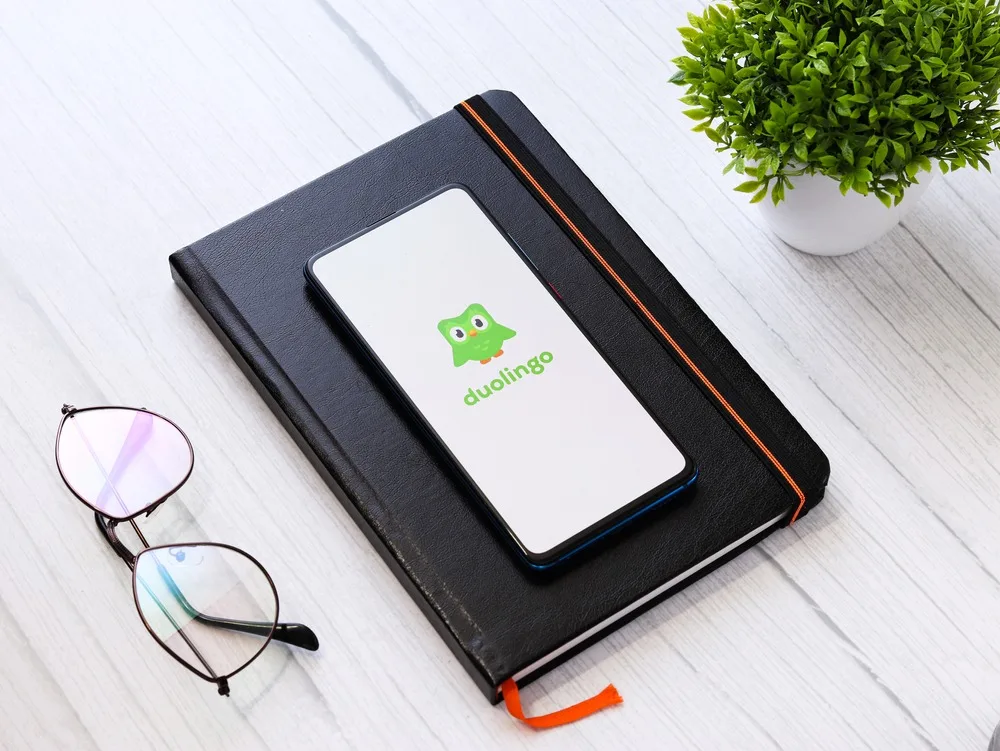
The Future of Language Learning: Can Duolingo Stay on Top?
Duolingo is the most popular language-learning app in the world, but will it stay that way? Technology is advancing fast, and competition is growing. The question isn’t just whether Duolingo can keep users engaged—it’s whether it can truly revolutionize language learning.
Here’s what could shape the future:
1. AI-Powered Language Learning: A Game-Changer?
Duolingo has already started using AI to personalize lessons, but what if AI could do more? Imagine a fully interactive AI tutor that listens, corrects, and responds like a real person.
Some companies are already working on AI conversation tools that simulate real-world dialogue. If Duolingo integrates this effectively, it could solve its biggest weakness—lack of real conversation practice.
2. Virtual & Augmented Reality in Language Learning
What if learning a new language didn’t just mean using an app—but stepping into a virtual world where you’re immersed in real conversations?
- VR language immersion: Imagine practicing Spanish while “walking” through the streets of Madrid in VR.
- AR real-world practice: Your phone’s camera could recognize objects and teach you words in real-time as you point at things.
Companies like Rosetta Stone and Mondly are experimenting with this. Will Duolingo follow?
3. More Competition from Niche Apps & Personalized Learning
Duolingo has a fun, engaging system—but it’s not for everyone. Some learners prefer a more structured approach, and new platforms are catering to those needs.
- Apps like Babbel and Pimsleur focus on real conversations.
- Others, like Anki, are built for serious memorization and deeper learning.
As competition grows, Duolingo will need to keep innovating to stay ahead.
4. Will Duolingo Ever Offer Full Fluency?
Right now, Duolingo is great for beginners—but most users eventually hit a wall.
If the company truly wants to dominate the language-learning space, it will need to bridge the gap between casual learners and those who want fluency.
This could mean:
- Live tutoring sessions integrated into the app
- More conversation-based learning
- Advanced grammar and writing exercises
If Duolingo can evolve beyond gamification into a more complete language-learning system, it could become the ultimate all-in-one tool.
Final Thoughts: What’s Next for Duolingo?
Duolingo changed the way millions of people approach language learning. But to stay relevant, it has to keep pushing boundaries.
With AI advancements, immersive learning, and stronger competitors, the future of language education is evolving fast. Whether Duolingo leads that future—or gets left behind—depends on how well it adapts.
One thing’s for sure: language learning will never be the same again.


